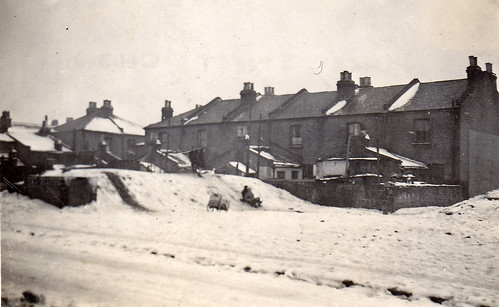
Taken during the grim winter of 1946-47, which was economically disastrous for Britain and helped spur the USA to initiate the Marshall Plan. These kids don't seem to have noticed, however. These houses were demolished in the 1950s to make way for a medium-rise public housing development now known as the 'Hogarth estate'. It is not often you find photographs of housing that was, at the time, considered substandard or 'slum'. Census records tell us that they had only two rooms per dwelling.
I sent this photo to the Brentwood and Chiswick local history journal and received this long reply from their editor:
Thank you so much for sending on this photograph - we were very interested to see it as photos of this part of Chiswick are extremely rare.
I think the photo shows James Street in the foreground, with most of the houses already demolished, and in the background the backs of the houses in Wood Street.
This area of Chiswick was always known as the "New Town" from the time when the Duke of Devonshire was selling off some parcels of land in 1821 and this nine-acre plot was developed as seven streets of housing for the poorer people of the parish. The houses were terraced and mostly very small, with just one room on each floor. One lady told me her memories of visiting her grandparents in James Street in the early 1900s - the house was right on the street and the front door opened into the one downstairs room which had a scullery with a concrete boiler (maybe this had been added since the 1820s). The stairs led into the upstairs bedroom which was divided in two by a curtain. The toilet was at the bottom of the garden.
After a hundred years it was surprising that the houses were still standing and still occupied, but there was talk of slum clearance and plans for extending the A4 road through the area. Some of the houses had already been demolished when World War II put a stop to housing developments, but bombs continued the work of demolition. People who were young in the 1940s tell of ignoring the 'Keep Out' signs and enjoying exciting games of hide and seek among the boarded up or half demolished houses - like the children toboganning in the photo.
Eventually in the 1950s the site was cleared and the council built the blocks of flats of the Hogarth estate.
Many thanks for sending the photo to us - it is great to have a record of the appearance of this under-recorded area.
Terraced houses with a 'two-up' separate from the 'two-down' still exist in Dublin. They were railwaymen's cottages and have since had bathrooms added. A friend lives in one in Broadstone Avenue, Phibsboro.
ReplyDeleteI'm sure if they hadn't been demolished they'd have been modernised and would now be as expensive as everything else in London.
ReplyDelete